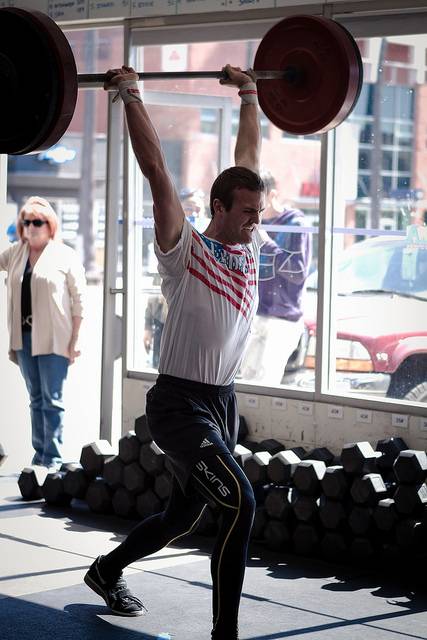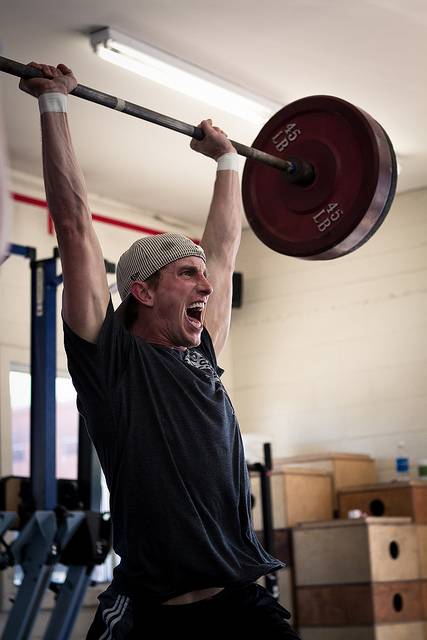Last week we talked about the snatch grip width, so naturally this week we are going to move on to the clean and jerk. I will not discuss the clean in any great detail, but the standard recommendation here is what we call a shoulder-width grip.
In actual fact, the clean grip taken is slightly wider than the shoulders. If we took this literally we would have the fingers squashed up against the deltoids at the top of the clean. That is both uncomfortable and quite inefficient. It’s also impinges on the flexibility. What you want is a somewhat wider than shoulder width grip so that the fingers are just outside the deltoids. We do not need to go much wider than this, as just as in the snatch a too-wide grip starts compromising pulling power (but unlike the snatch a wide grip adversely affects flexibility).
Clean Grip vs. Jerk Grip
Where there is room for a little more controversy is in the jerk portion of the lift. Most lifters attempt to jerk with pretty much the same width grip as they used in executing the clean immediately prior. Some lifters do change the width of the grip, but this should be avoided if possible because this takes extra effort at a time when you are seriously running out of energy. Changing the width is done by using the legs to raise the bar off the chest and the lifter moves his hands while the bar is in midair. This exercise can be problematic if the lifter does not get his hands in the right position after one such attempt. If the bar is still feeling a bit uncomfortable the lifter must repeat the process, thereby using up yet more energy.
And don’t forget when this happens a psych-out becomes ever more probable. So it’s best to learn how to jerk in the same position as you clean. The hands do not have to remain encircled on the bar at the start of the lift. As long as the bar is within the fingers the hands can re-grip the bar on the way up during the jerk. Experienced lifters do this all the time. Nevertheless some lifters do change the width of the grip. Why do they do this if it is not recommended?
 Changing the Jerk Grip
Changing the Jerk Grip
One of the reasons lifters change their grip has to do with flexibility. Narrower grips require more flexible shoulders to get the bar to the desired point over the heels and behind the lifter’s ear. If you are too inflexible to comfortably get the bar into that position, or until you are sufficiently flexible, you will have to move your grip outwards. (As an aside, women are usually much more flexible than men and generally do not have this problem.) But the cost to the lifter here is twofold – extra energy must be expended to change the grip width while bone-on-bone support will be somewhat compromised. This skeletal support is what holds a jerk up, not so much the muscles of the arms. Therefore, the wider the grip the more that support is compromised.
The Bulgarian Grip
In recent years some Bulgarian lifters have been observed to take dramatically wider grips in the jerk portion of the lift. When locked out, the lift almost looks like a narrower grip snatch. Some people when viewing those lifts assumed the Bulgarians had learned a new secret – i.e., move the grip out and jerk more weight since you will not have to throw the bar quite so high. This may have made some sort of sense on first observation, but not when you investigate a little further.
True, a wide grip does not have any problems in the jerk drive portion of the lift since the legs do all that work, not the arms. But a big problem occurs in the lockout with the arms at such a wide angle. Lockout ability is just not there. The lifter better be very strong in the shoulders in order to hold a bar long enough in this position – and he better not loosen the shoulders. With much more weight than a snatch and a much wider grip than a normal jerk, it’s going to be difficult to hold that bar in place if it starts moving backwards or forwards on the lifter. It would be like trying to hold a snatch but with 25% more weight on the bar. This is far less of a problem with a shoulder-width grip.
Wide Grip vs. Bar Bend
 And there is another problem with this wide grip jerk. And that one relates back to my articles of a couple weeks ago concerning the utilization of the bar’s elasticity. With a shoulder-width grip the point where the hands are gripping the bar serves as the fulcrum for a bending bar that you can then later take advantage of to drive the bar a little higher. But, it if you move the hands outwards that fulcrum is also moved outwards and the lever, i.e. the bar, becomes considerably shorter and the bar will not bend as much. When that happens there is far less energy in the bar to take advantage of on the jerk drive. With both of those factors in mind it can be seen that a wide grip jerk is not desirable. If you have flexibility problems in the jerk maybe you can move out on the bar little bit, but not a lot. You best work on your flexibility.
And there is another problem with this wide grip jerk. And that one relates back to my articles of a couple weeks ago concerning the utilization of the bar’s elasticity. With a shoulder-width grip the point where the hands are gripping the bar serves as the fulcrum for a bending bar that you can then later take advantage of to drive the bar a little higher. But, it if you move the hands outwards that fulcrum is also moved outwards and the lever, i.e. the bar, becomes considerably shorter and the bar will not bend as much. When that happens there is far less energy in the bar to take advantage of on the jerk drive. With both of those factors in mind it can be seen that a wide grip jerk is not desirable. If you have flexibility problems in the jerk maybe you can move out on the bar little bit, but not a lot. You best work on your flexibility.
So you can see now the importance of grip width and also how this relates to barbell elasticity. In the snatch grip, width is very important but bar elasticity is not a factor to that wide grip. In the clean, grip width should be slightly wider than shoulder width, because, simply put, nothing else works very well. This is where bar elasticity is important, though. You want good elasticity at the bottom of your clean to help you rise out of the squat. In the jerk, you should also be at the so-called shoulder width position. The drive is better with narrower hand spacing and bar elasticity is greater. All of this means it is important for an athlete in the early stages of his or her career to know where to grip the bar and how to take advantage of its elasticity.
Photo 1 courtesy of CrossFit Impulse.
Photo 2 courtesy of CrossFit LA.
Photo 3 courtesy of Miguel Tapia Images and CrossFit LA.






